For many dog lovers, the joy of pet ownership is often clouded by persistent allergies. The idea of a “hypoallergenic” dog offers a beacon of hope, promising a life with canine companionship free from sniffles, sneezes, and itchy eyes. But when your heart is set on a larger breed, the search for a truly low-shedding, allergy-friendly companion can feel even more challenging. The good news is that several magnificent hypoallergenic big dogs that don’t shed exist, offering the impressive stature and robust personalities you desire without the excessive dander.
This comprehensive guide delves into what makes a dog hypoallergenic and highlights some of the best large breeds that are known for their minimal shedding, making them ideal choices for individuals and families dealing with allergies.
Understanding Hypoallergenic Dogs
The term “hypoallergenic” can be misleading. No dog is 100% allergen-free. All dogs produce allergens, primarily through their dander (flakes of dead skin), saliva, and urine. These allergens are tiny protein particles that can trigger allergic reactions in sensitive individuals, leading to symptoms like coughing, itching, wheezing, and skin rashes.
The key distinction with hypoallergenic dogs lies in their coat type and shedding patterns. Breeds labeled as hypoallergenic typically shed very little hair or have coats that trap dander and shed hair, preventing it from spreading as widely in the environment. This significantly reduces the amount of airborne allergens, making them a much better fit for many allergy sufferers. However, it’s crucial to remember that individual reactions vary, and spending time with a specific breed before committing is always recommended.
What Makes a Dog “Hypoallergenic” for Allergy Sufferers?
The primary factor contributing to a dog’s hypoallergenic status is its coat. Dogs that shed less also release less dander into their surroundings. These low-shedding coats often come in various forms, such as:
- Curly or Wavy Coats: These coats tend to trap loose hair and dander within the curls, preventing it from falling out onto furniture and floors. Breeds like Poodles and Portuguese Water Dogs exemplify this.
- Wiry Coats: Some terriers have wiry coats that are also low-shedding. These require specific grooming techniques like hand-stripping to remove dead hair.
- Hairless Breeds: While not truly “big” in the conventional sense for all varieties, the standard sizes of hairless breeds eliminate the hair-related dander issue almost entirely.
- Single Coat vs. Double Coat: Many low-shedding breeds possess a single coat rather than a double coat (which includes a soft undercoat that sheds seasonally).
While the coat is central, the amount of saliva and urine a dog produces can also play a role. Regular grooming, bathing, and maintaining a clean home environment are essential strategies to further minimize allergens, even with a hypoallergenic dog. For those exploring various options beyond large breeds, there are also numerous breeds of dogs that don’t shed across all sizes.
Top Hypoallergenic Big Dogs That Don’t Shed
Finding a large dog that fits into an allergy-sensitive household requires careful consideration of size, temperament, and, most importantly, shedding habits. Here are some of the most popular and highly recommended big hypoallergenic dog breeds known for their minimal shedding, offering both impressive presence and a more allergy-friendly environment.
1. Standard Poodle
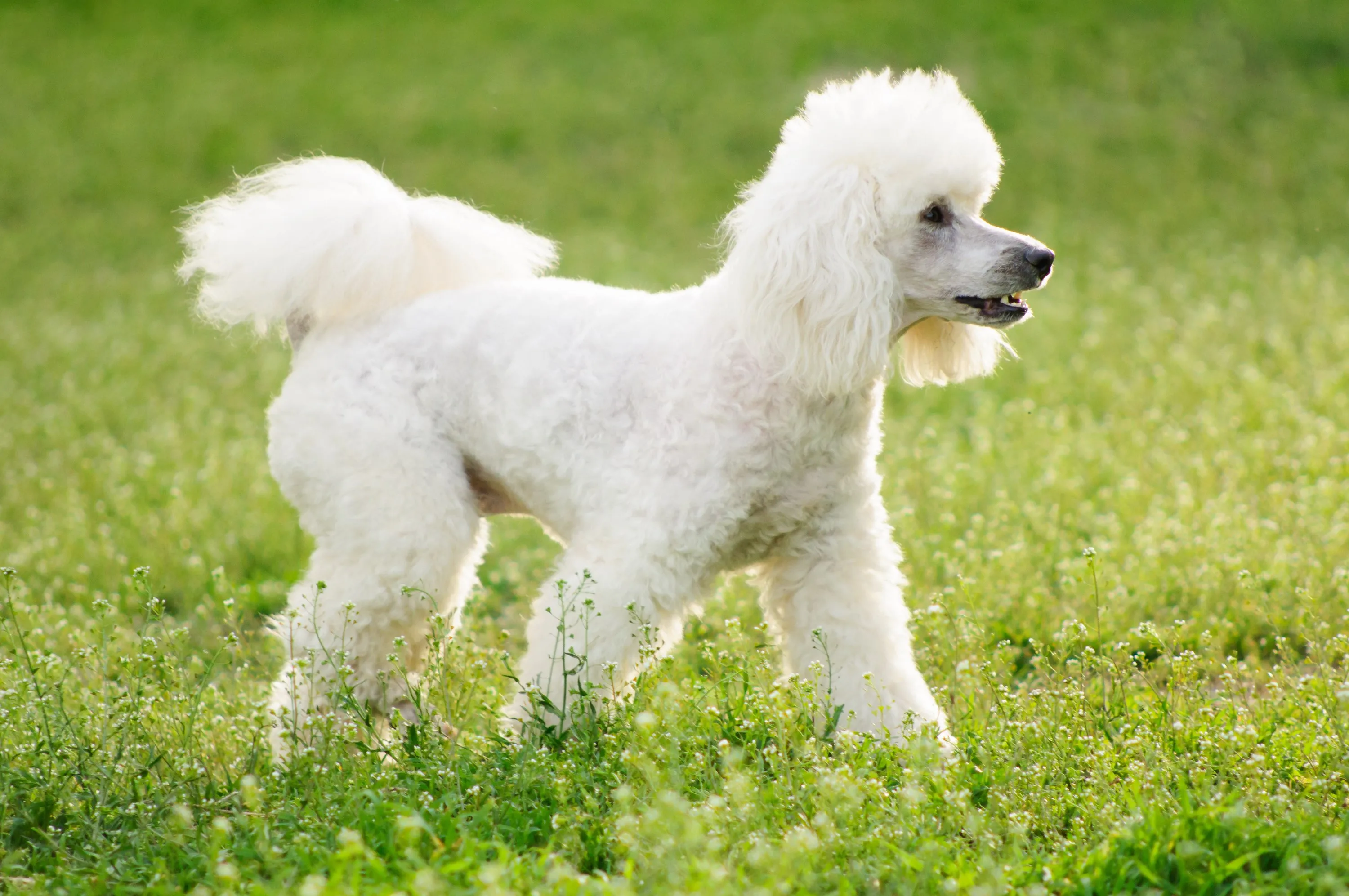 Standard Poodle with a white curly coat running through green grass, a prime example of a large hypoallergenic dog that doesn't shed.The Standard Poodle stands as an iconic symbol among hypoallergenic breeds. Originally bred as water retrievers, these elegant dogs are known for their exceptional intelligence, trainability, and distinctive curly coats. Standard Poodles are the largest of the three Poodle varieties, often weighing between 45 to 70 pounds and standing over 15 inches tall at the shoulder. Their dense, curly coat is single-layered and sheds very minimally, effectively trapping loose hair and dander within its coils. This makes them an excellent choice for allergy sufferers seeking a larger canine companion.
Standard Poodle with a white curly coat running through green grass, a prime example of a large hypoallergenic dog that doesn't shed.The Standard Poodle stands as an iconic symbol among hypoallergenic breeds. Originally bred as water retrievers, these elegant dogs are known for their exceptional intelligence, trainability, and distinctive curly coats. Standard Poodles are the largest of the three Poodle varieties, often weighing between 45 to 70 pounds and standing over 15 inches tall at the shoulder. Their dense, curly coat is single-layered and sheds very minimally, effectively trapping loose hair and dander within its coils. This makes them an excellent choice for allergy sufferers seeking a larger canine companion.
Beyond their allergy-friendly coat, Standard Poodles are highly adaptable and form strong bonds with their families. They require consistent mental stimulation and regular exercise, thriving on activities like retrieving, swimming, and agility. Their grooming needs are significant; daily brushing is necessary to prevent matting, and professional grooming every 4-6 weeks is essential to maintain their coat and keep it free of tangles.
2. Giant Schnauzer
 Black Giant Schnauzer with a wet, wiry coat standing in a park, showcasing its large, non-shedding build.The Giant Schnauzer is a robust and powerful breed, making it one of the biggest hypoallergenic dogs available. These dogs can weigh between 55 to 85 pounds and stand up to 27.5 inches tall. Their dense, wiry double coat sheds very little, similar to other members of the Schnauzer family. While they have an undercoat, it’s not prone to heavy shedding, and the wiry outer coat helps to contain dander.
Black Giant Schnauzer with a wet, wiry coat standing in a park, showcasing its large, non-shedding build.The Giant Schnauzer is a robust and powerful breed, making it one of the biggest hypoallergenic dogs available. These dogs can weigh between 55 to 85 pounds and stand up to 27.5 inches tall. Their dense, wiry double coat sheds very little, similar to other members of the Schnauzer family. While they have an undercoat, it’s not prone to heavy shedding, and the wiry outer coat helps to contain dander.
Known for their loyalty, intelligence, and protective nature, Giant Schnauzers make excellent guardians and dedicated family members. They are high-energy dogs that require extensive daily exercise, including long walks, runs, and engaging playtime to keep them mentally and physically stimulated. Their grooming involves regular brushing and professional grooming, often requiring hand-stripping or clipping to maintain the coat’s texture and minimize shedding further.
3. Portuguese Water Dog
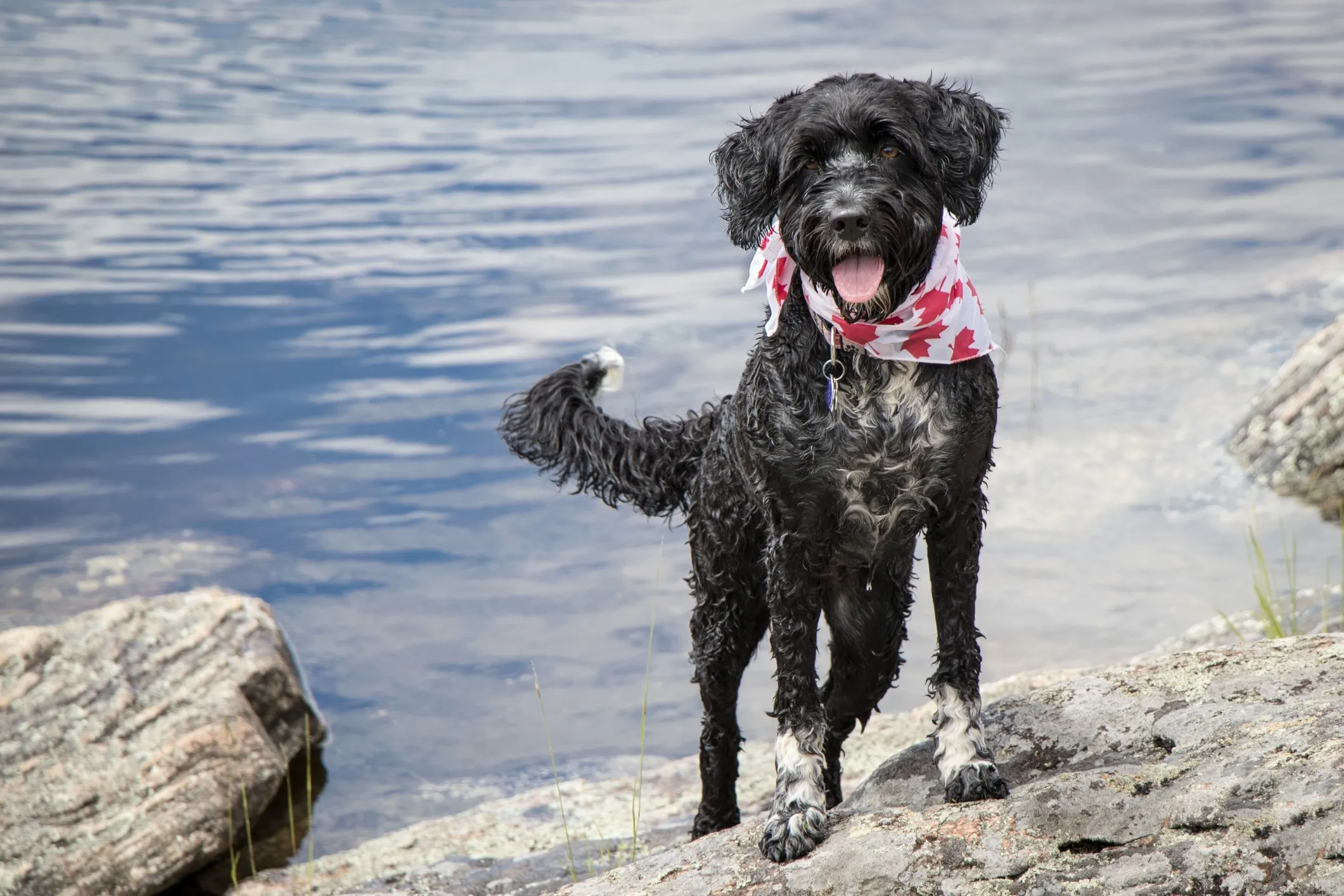 Black and white Portuguese Water Dog wearing a red maple leaf bandana by the water, an active medium-large hypoallergenic dog.The Portuguese Water Dog is a dynamic and intelligent breed, originally bred to assist fishermen. These medium-large dogs typically weigh between 35 to 60 pounds and stand 17 to 23 inches tall. Their thick, curly, or wavy single coat is virtually non-shedding, making them a fantastic option for individuals with allergies. Like the Poodle, their coat traps loose hair and dander.
Black and white Portuguese Water Dog wearing a red maple leaf bandana by the water, an active medium-large hypoallergenic dog.The Portuguese Water Dog is a dynamic and intelligent breed, originally bred to assist fishermen. These medium-large dogs typically weigh between 35 to 60 pounds and stand 17 to 23 inches tall. Their thick, curly, or wavy single coat is virtually non-shedding, making them a fantastic option for individuals with allergies. Like the Poodle, their coat traps loose hair and dander.
Portuguese Water Dogs are highly energetic, outgoing, and thrive on activity. They possess a strong work ethic and enjoy various canine sports, especially those involving water. They need significant daily exercise and mental challenges to prevent boredom. Regular grooming is crucial for this breed; their coat requires frequent brushing to prevent matting and professional clipping every 6-8 weeks to keep it in optimal condition.
4. Labradoodle (Standard Size)
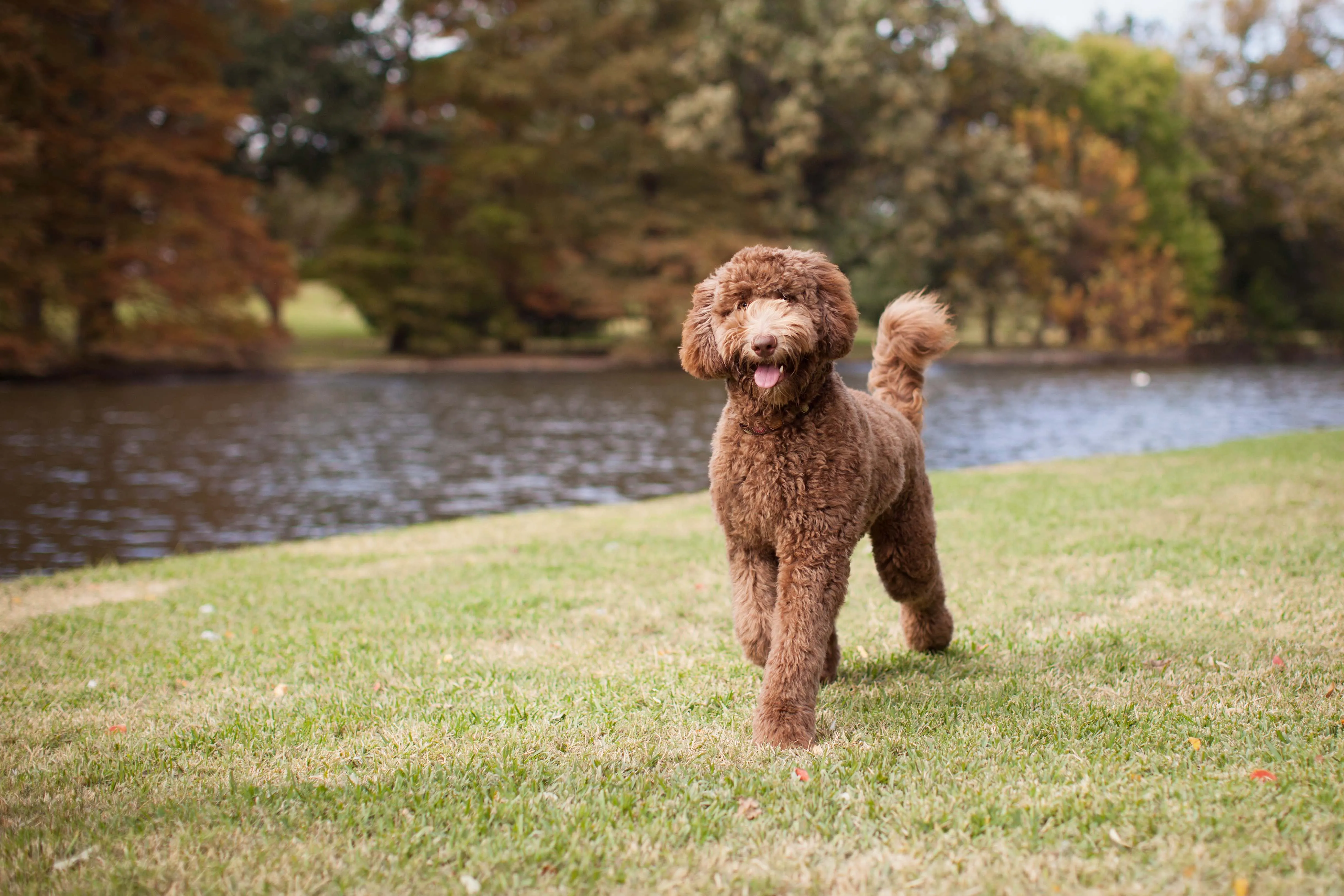 Brown Standard Labradoodle walking through a park, embodying a friendly large hypoallergenic dog.The Labradoodle, a cross between a Labrador Retriever and a Poodle, was originally bred to be a hypoallergenic service dog. Standard Labradoodles are large dogs, often weighing 50 to 75 pounds and standing 21 to 24 inches tall. Their coat varies depending on the genetics inherited from their parents, ranging from wavy fleece to curly wool, but typically sheds minimally, especially the wool or fleece types. This characteristic, combined with their friendly and intelligent nature, makes them incredibly popular among allergy sufferers looking for a large family pet.
Brown Standard Labradoodle walking through a park, embodying a friendly large hypoallergenic dog.The Labradoodle, a cross between a Labrador Retriever and a Poodle, was originally bred to be a hypoallergenic service dog. Standard Labradoodles are large dogs, often weighing 50 to 75 pounds and standing 21 to 24 inches tall. Their coat varies depending on the genetics inherited from their parents, ranging from wavy fleece to curly wool, but typically sheds minimally, especially the wool or fleece types. This characteristic, combined with their friendly and intelligent nature, makes them incredibly popular among allergy sufferers looking for a large family pet.
Labradoodles are known for their affectionate temperament, trainability, and eagerness to please. They are highly active and require substantial daily exercise and mental stimulation. Early socialization and consistent training are key to developing a well-behaved Labradoodle. Their grooming needs depend on their coat type, but generally involve regular brushing to prevent matting and professional trims every few months.
5. Goldendoodle (Standard Size)
 Standard Goldendoodle lying on a couch with a person, highlighting its gentle nature as a large hypoallergenic companion.Similar to the Labradoodle, the Goldendoodle is a beloved “designer” breed, a cross between a Golden Retriever and a Poodle. Standard Goldendoodles are large dogs, typically weighing 50 to 80 pounds and measuring 20 to 24 inches at the shoulder. Their coat types range from straight to wavy to curly, with the wavy and curly varieties being the most allergy-friendly and low-shedding. They are renowned for their gentle, intelligent, and affectionate nature, making them excellent family dogs.
Standard Goldendoodle lying on a couch with a person, highlighting its gentle nature as a large hypoallergenic companion.Similar to the Labradoodle, the Goldendoodle is a beloved “designer” breed, a cross between a Golden Retriever and a Poodle. Standard Goldendoodles are large dogs, typically weighing 50 to 80 pounds and measuring 20 to 24 inches at the shoulder. Their coat types range from straight to wavy to curly, with the wavy and curly varieties being the most allergy-friendly and low-shedding. They are renowned for their gentle, intelligent, and affectionate nature, making them excellent family dogs.
Goldendoodles are highly social and energetic, requiring regular exercise and plenty of interaction with their human companions. They are intelligent and generally easy to train. To keep their low-shedding coat healthy and mat-free, frequent brushing with a slicker brush is essential, along with periodic professional grooming.
6. Irish Water Spaniel
 Brown Irish Water Spaniel in profile, showcasing its distinct curly coat and intelligent expression.The Irish Water Spaniel is a distinctive and athletic breed, easily recognized by its unique “rat tail” and dense, crisply curled liver-colored coat. These medium to large dogs typically weigh 55 to 68 pounds and stand 21 to 24 inches tall. Their waterproof, low-shedding coat makes them an excellent choice for allergy sufferers, especially those who enjoy outdoor activities.
Brown Irish Water Spaniel in profile, showcasing its distinct curly coat and intelligent expression.The Irish Water Spaniel is a distinctive and athletic breed, easily recognized by its unique “rat tail” and dense, crisply curled liver-colored coat. These medium to large dogs typically weigh 55 to 68 pounds and stand 21 to 24 inches tall. Their waterproof, low-shedding coat makes them an excellent choice for allergy sufferers, especially those who enjoy outdoor activities.
Known for their friendly, intelligent, and often clownish personality, Irish Water Spaniels are eager to please and highly trainable. They possess a high energy level and require significant daily exercise, including swimming, retrieving games, and long walks. Regular grooming, including brushing and occasional trimming, is necessary to prevent mats and maintain the health of their unique coat.
7. Bernedoodle
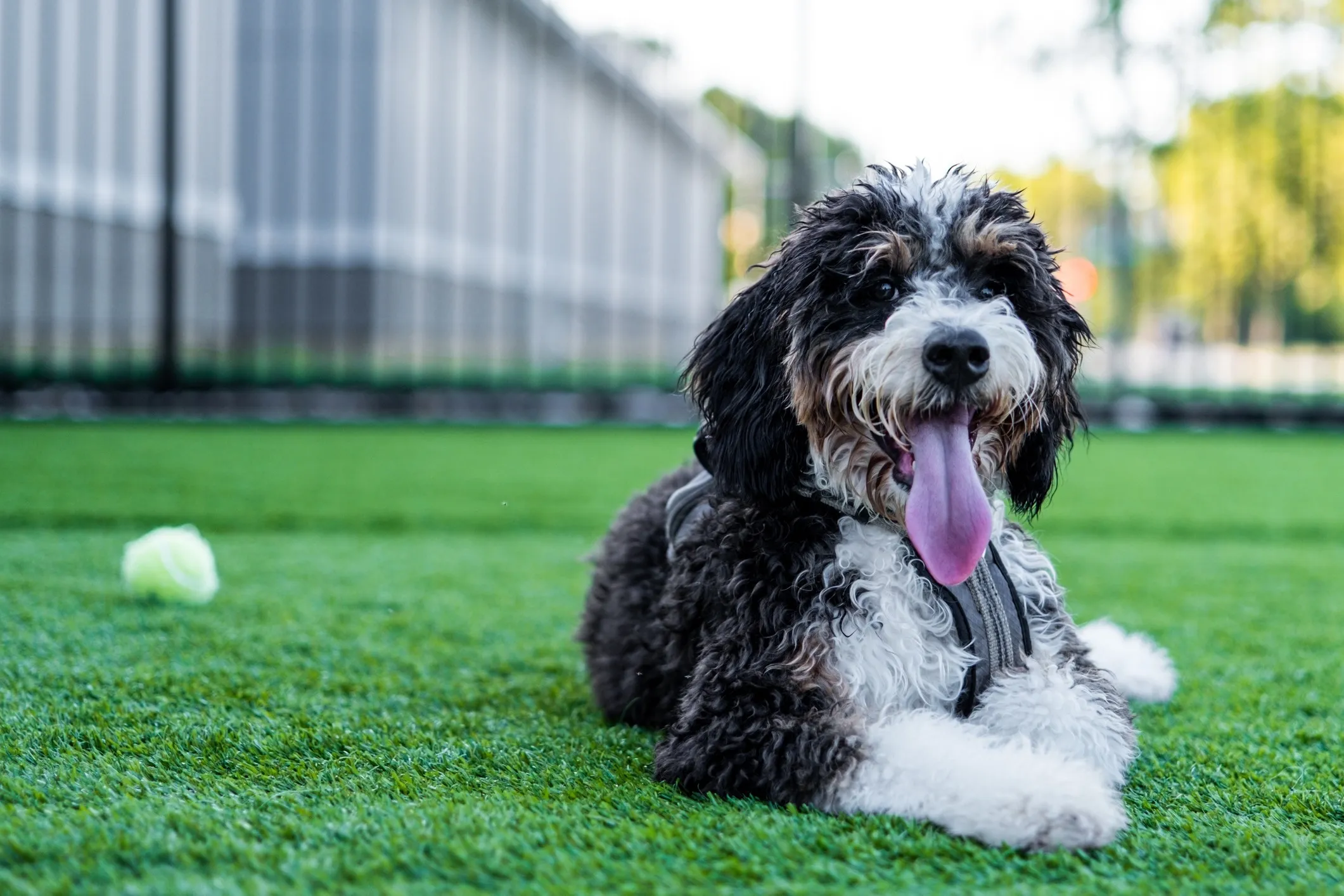 Large Bernedoodle dog lying in grass with its tongue out, displaying a relaxed and friendly disposition.The Bernedoodle, a cross between a Bernese Mountain Dog and a Poodle, combines the best traits of both breeds into a wonderful large hypoallergenic companion. Standard Bernedoodles can be quite large, weighing 70 to 90 pounds (and sometimes more) and standing 23 to 29 inches tall. Their coats vary from wavy to curly, with the curlier types being the most low-shedding and allergy-friendly.
Large Bernedoodle dog lying in grass with its tongue out, displaying a relaxed and friendly disposition.The Bernedoodle, a cross between a Bernese Mountain Dog and a Poodle, combines the best traits of both breeds into a wonderful large hypoallergenic companion. Standard Bernedoodles can be quite large, weighing 70 to 90 pounds (and sometimes more) and standing 23 to 29 inches tall. Their coats vary from wavy to curly, with the curlier types being the most low-shedding and allergy-friendly.
These dogs are cherished for their laid-back yet playful demeanor, intelligence, and deep loyalty to their families. They are generally gentle with children and other pets, making them outstanding family dogs. Bernedoodles require moderate to high levels of exercise, thriving on adventures and playtime. Regular brushing and professional grooming appointments are essential to manage their thick, low-shedding coats and prevent matting.
8. Afghan Hound
 Majestic gray and tan Afghan Hound looking at the camera, with its distinctive long, flowing coat.The Afghan Hound is an ancient and aristocratic breed, instantly recognizable by its striking long, flowing coat and regal appearance. These large dogs typically weigh 50 to 60 pounds and stand 25 to 27 inches tall. Despite their luxurious coats, Afghan Hounds are considered low-shedding and can be suitable for some allergy sufferers. Their hair is more akin to human hair than fur, and while it requires extensive grooming, it doesn’t shed in the same way a double-coated breed would.
Majestic gray and tan Afghan Hound looking at the camera, with its distinctive long, flowing coat.The Afghan Hound is an ancient and aristocratic breed, instantly recognizable by its striking long, flowing coat and regal appearance. These large dogs typically weigh 50 to 60 pounds and stand 25 to 27 inches tall. Despite their luxurious coats, Afghan Hounds are considered low-shedding and can be suitable for some allergy sufferers. Their hair is more akin to human hair than fur, and while it requires extensive grooming, it doesn’t shed in the same way a double-coated breed would.
Afghan Hounds are known for their independent and dignified nature, often described as aloof but deeply affectionate with their families. They are incredibly fast and agile, requiring considerable daily exercise, including secure off-leash running opportunities. Their magnificent coat demands significant dedication to grooming, including daily brushing to prevent mats and tangles, as well as regular bathing.
9. Barbet
 Close-up of a curly red Barbet dog face, highlighting its shaggy, woolly, and friendly appearance.The Barbet, pronounced “bar-bay,” is a cheerful and rustic French water dog. These robust, medium-large dogs typically weigh 35 to 65 pounds and stand 20 to 25 inches tall. Their defining characteristic is their dense, woolly, and curly coat, which is low-shedding and water-resistant. The name “Barbet” actually comes from the French word barbe, meaning “beard,” a nod to their characteristic hairy chin and facial hair. This breed is an excellent choice for allergy sufferers who enjoy an active lifestyle.
Close-up of a curly red Barbet dog face, highlighting its shaggy, woolly, and friendly appearance.The Barbet, pronounced “bar-bay,” is a cheerful and rustic French water dog. These robust, medium-large dogs typically weigh 35 to 65 pounds and stand 20 to 25 inches tall. Their defining characteristic is their dense, woolly, and curly coat, which is low-shedding and water-resistant. The name “Barbet” actually comes from the French word barbe, meaning “beard,” a nod to their characteristic hairy chin and facial hair. This breed is an excellent choice for allergy sufferers who enjoy an active lifestyle.
Barbets are known for their friendly, intelligent, and jovial personalities. They are eager to please and highly trainable, excelling in activities like obedience, agility, and especially water sports. They require regular exercise to channel their energy. Their woolly coat needs diligent grooming, including brushing two to three times a week to prevent matting, particularly after swimming, and regular professional trims.
10. Standard Schnauzer
 Gray Standard Schnauzer standing alertly in a field, showcasing its intelligent and sturdy build.While smaller than its Giant counterpart, the Standard Schnauzer is a sturdy and impressive medium-large breed, weighing between 35 to 45 pounds and standing 17 to 20 inches tall. Like all Schnauzers, they possess a wiry, low-shedding coat that makes them a viable option for allergy-prone individuals. They embody the classic Schnauzer look, with distinctive eyebrows and a beard.
Gray Standard Schnauzer standing alertly in a field, showcasing its intelligent and sturdy build.While smaller than its Giant counterpart, the Standard Schnauzer is a sturdy and impressive medium-large breed, weighing between 35 to 45 pounds and standing 17 to 20 inches tall. Like all Schnauzers, they possess a wiry, low-shedding coat that makes them a viable option for allergy-prone individuals. They embody the classic Schnauzer look, with distinctive eyebrows and a beard.
Standard Schnauzers are highly intelligent, alert, and spirited dogs. They are known for their loyalty and make excellent watchdogs. These dogs thrive on activity and require at least an hour of vigorous exercise daily, enjoying long walks, games of fetch, and solving dog puzzle toys for mental stimulation. Their coat requires regular brushing and professional hand-stripping or clipping to maintain its texture and minimize any potential dander release.
11. Lagotto Romagnolo
 Two Lagotto Romagnolo dogs lying in dirt staring at the camera, highlighting their curly coats and rustic charm.The Lagotto Romagnolo is an ancient Italian breed renowned for its curly, woolly coat and its exceptional truffle-hunting abilities. These medium-sized dogs typically weigh 24 to 35 pounds and stand 16 to 19 inches tall. While on the smaller end of “big,” their robust build and unique coat make them a strong candidate for this list. Their dense, non-shedding coat is a key hypoallergenic feature, designed to protect them from cold water during their retrieving days.
Two Lagotto Romagnolo dogs lying in dirt staring at the camera, highlighting their curly coats and rustic charm.The Lagotto Romagnolo is an ancient Italian breed renowned for its curly, woolly coat and its exceptional truffle-hunting abilities. These medium-sized dogs typically weigh 24 to 35 pounds and stand 16 to 19 inches tall. While on the smaller end of “big,” their robust build and unique coat make them a strong candidate for this list. Their dense, non-shedding coat is a key hypoallergenic feature, designed to protect them from cold water during their retrieving days.
Lagotti Romagnoli are intelligent, eager to please, and generally good-natured, often making them excellent family dogs that get along well with children and other pets. They are energetic and require ample mental and physical exercise, thriving on activities that engage their keen sense of smell. Their woolly coat requires regular care, including brushing and periodic clipping, to prevent matting and maintain hygiene.
12. Soft Coated Wheaten Terrier
 Soft Coated Wheaten Terrier dog on a log in a forest, showing its silky, wavy coat.The Soft Coated Wheaten Terrier is a spirited Irish breed known for its distinctive silky, wavy coat that feels incredibly soft to the touch. These medium-sized dogs weigh 30 to 40 pounds and stand 17 to 19 inches tall. Their low-shedding coat is a significant benefit for allergy sufferers, as it traps dander rather than releasing it into the environment.
Soft Coated Wheaten Terrier dog on a log in a forest, showing its silky, wavy coat.The Soft Coated Wheaten Terrier is a spirited Irish breed known for its distinctive silky, wavy coat that feels incredibly soft to the touch. These medium-sized dogs weigh 30 to 40 pounds and stand 17 to 19 inches tall. Their low-shedding coat is a significant benefit for allergy sufferers, as it traps dander rather than releasing it into the environment.
Wheatens are lively, friendly, and affectionate dogs with a playful disposition. They maintain a high energy level throughout their lives and require ample exercise and mental stimulation to prevent boredom and destructive behaviors. They are intelligent and generally good with families who can match their enthusiasm. Regular daily brushing is crucial to prevent their soft coat from matting, and professional grooming every 4-6 weeks is often recommended.
13. Standard Xoloitzcuintli
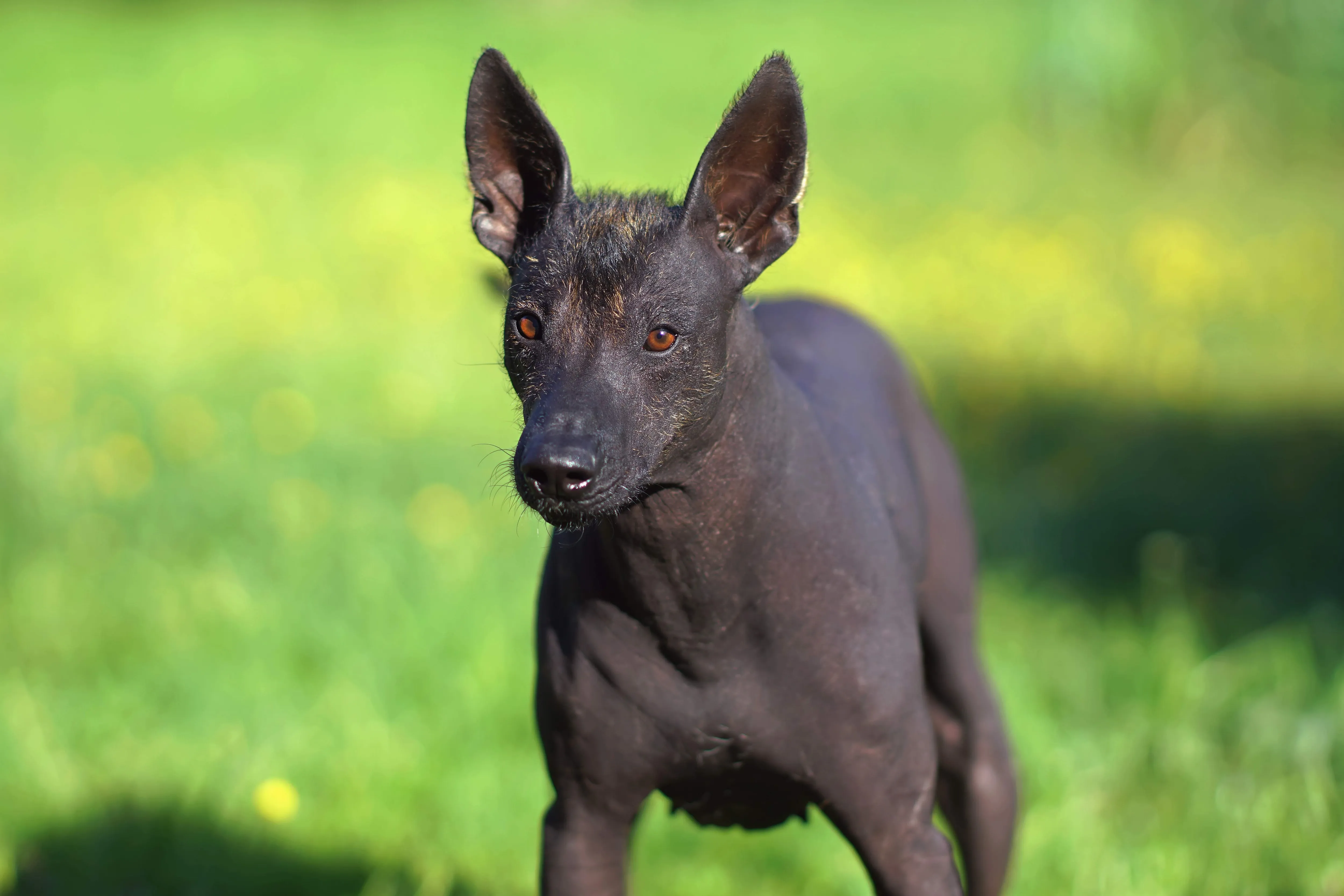 Black Mexican Hairless Dog (Standard Xoloitzcuintli) standing in grass, showcasing its unique hairless appearance.The Xoloitzcuintli, also known as the Mexican Hairless Dog, is an ancient and unique breed. While they come in three sizes (toy, miniature, and standard), the Standard Xoloitzcuintli is a large dog, weighing 30 to 55 pounds and standing 18 to 23 inches tall. As a hairless breed, they are naturally hypoallergenic, though some varieties have a short, fine coat that also sheds minimally. The absence of hair means significantly less dander to trigger allergies.
Black Mexican Hairless Dog (Standard Xoloitzcuintli) standing in grass, showcasing its unique hairless appearance.The Xoloitzcuintli, also known as the Mexican Hairless Dog, is an ancient and unique breed. While they come in three sizes (toy, miniature, and standard), the Standard Xoloitzcuintli is a large dog, weighing 30 to 55 pounds and standing 18 to 23 inches tall. As a hairless breed, they are naturally hypoallergenic, though some varieties have a short, fine coat that also sheds minimally. The absence of hair means significantly less dander to trigger allergies.
Xolos are known for being calm, intelligent, and loyal companions, often forming strong bonds with their families. They require regular exercise but are not overly hyperactive, making them adaptable to various living situations as long as their needs are met. Skin care is paramount for the hairless variety, including moisturizing, sunscreen, and protection from cold weather.
14. Standard Peruvian Inca Orchid
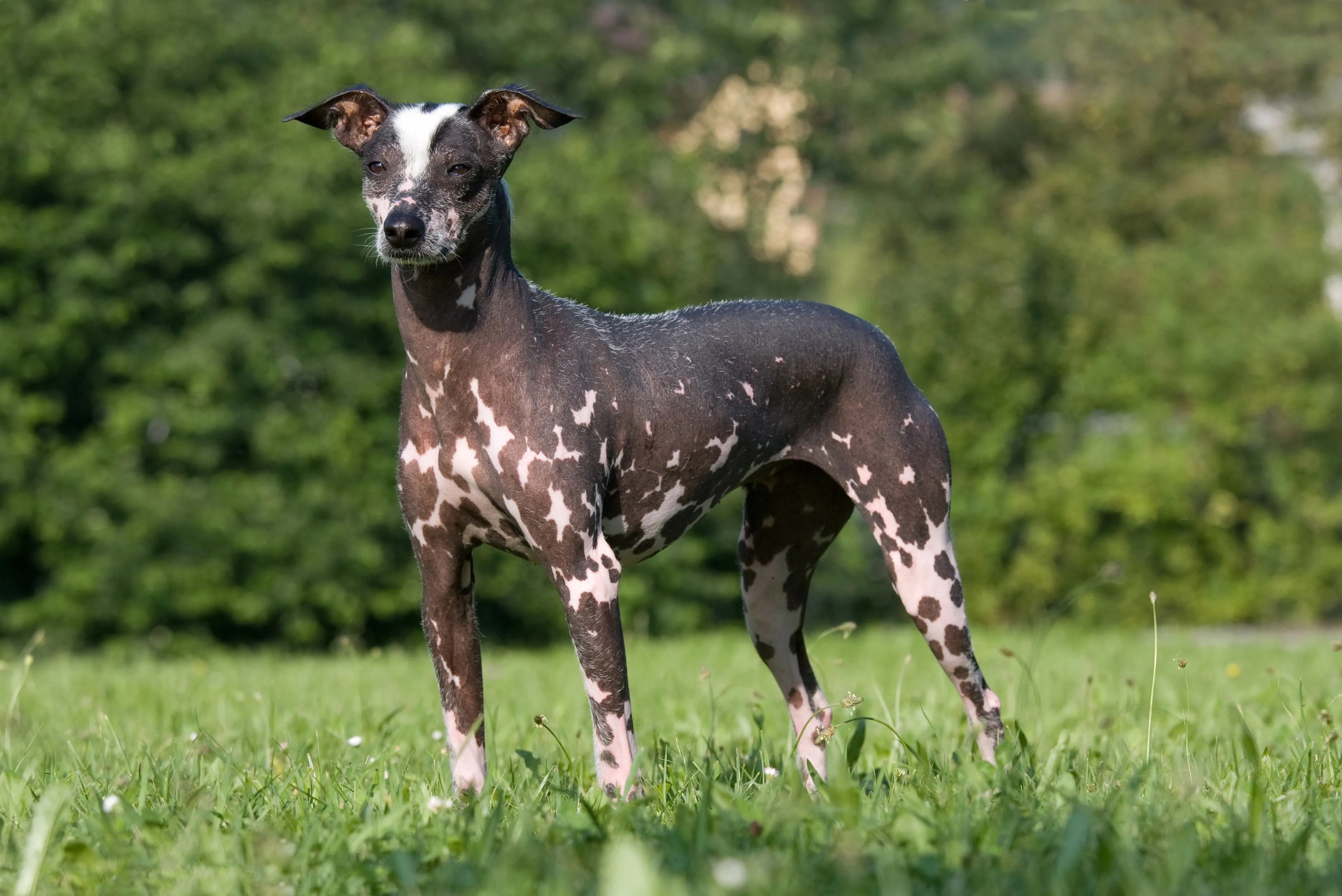 Peruvian Inca Orchid dog, illustrating its rare and hairless form.Similar to the Xoloitzcuintli, the Peruvian Inca Orchid is another ancient hairless breed that offers a hypoallergenic option. They also come in three sizes, with the Standard or Large variety weighing 25 to 55 pounds and standing 20 to 26 inches tall. Their nearly hairless body ensures a very low allergen footprint, making them highly suitable for severe allergy sufferers.
Peruvian Inca Orchid dog, illustrating its rare and hairless form.Similar to the Xoloitzcuintli, the Peruvian Inca Orchid is another ancient hairless breed that offers a hypoallergenic option. They also come in three sizes, with the Standard or Large variety weighing 25 to 55 pounds and standing 20 to 26 inches tall. Their nearly hairless body ensures a very low allergen footprint, making them highly suitable for severe allergy sufferers.
Peruvian Inca Orchids are known for being noble, affectionate, and protective towards their families, though they can be reserved with strangers. They are energetic and agile dogs that require regular exercise and mental engagement. Like other hairless breeds, their skin needs protection from the sun and cold, and regular moisturizing is important to keep their skin healthy.
Living Happily with a Large Hypoallergenic Dog
Bringing a large, low-shedding hypoallergenic dog into your home is a rewarding experience, but it requires commitment to certain practices to keep allergens at bay and ensure both you and your furry friend thrive.
Keep Up With Grooming
Even low-shedding dogs need regular grooming. Their coats, whether curly, wiry, or silky, tend to trap dander and loose hair, which must be removed through consistent brushing.
- Brushing: Aim for daily or every-other-day brushing to remove trapped dander and prevent matting, especially for breeds with longer or dense curly coats like Poodles, Goldendoodles, and Afghan Hounds.
- Bathing: Regular bathing (every 4-6 weeks) with a gentle, dog-specific shampoo can help wash away dander and allergens from their skin and coat. Some owners find that using specialized dander-reducing shampoos can be beneficial.
- Professional Grooming: Many large hypoallergenic breeds require professional grooming every 6-8 weeks for clipping, trimming, or hand-stripping to maintain their coat health and structure. This can be a significant ongoing cost, so budget accordingly or learn home grooming techniques.
Maintain a Clean House
While your dog might be low-shedding, allergens still exist in their saliva and urine. A clean home environment is crucial for managing allergies.
- Vacuum Regularly: Use a vacuum cleaner with a HEPA filter to capture pet dander from carpets and upholstery.
- Dust Frequently: Dust surfaces with a damp cloth to pick up airborne particles.
- Wash Bedding: Regularly wash pet bedding, throw blankets, and your own bedding in hot water.
- Air Purification: Consider using HEPA air purifiers in main living areas and bedrooms to help reduce airborne allergens.
- Designated Dog Areas: Create specific zones where your dog primarily stays, and areas (like bedrooms) where they might have limited access, to create allergen-reduced sanctuaries.
Talk to Your Doctor
If you have severe allergies, it’s always best to consult with your healthcare provider or an allergist before bringing any dog home, even a hypoallergenic one. They can offer advice on managing your symptoms and recommend treatments such as medication, nasal sprays, or allergy shots (immunotherapy). Avoiding close contact with a dog’s saliva or urine can also help reduce reactions, as these bodily fluids contain allergens.
Important Considerations Before Bringing Home a Big Hypoallergenic Dog
Choosing a large dog, even an allergy-friendly one, involves more than just their coat type. It’s a significant commitment that impacts your lifestyle.
- Space Requirements: Large dogs need ample space to move around comfortably, both indoors and outdoors. A house with a securely fenced yard is often ideal, though some large breeds can adapt to apartment living if they receive sufficient exercise.
- Exercise Needs: Big dogs, especially those bred for working roles like many on this list, often have high energy levels and require extensive daily exercise to stay happy and well-behaved. This could include long walks, runs, hikes, or vigorous play sessions.
- Training and Socialization: Due to their size and strength, early and consistent training and socialization are paramount for large breeds. A well-trained large dog is a joy, while an untrained one can be challenging to manage.
- Cost of Care: Large dogs generally incur higher costs for food, veterinary care (medications, surgeries often scale with weight), and grooming. Factor these into your budget.
- Temperament Matching: Research the typical temperament of your chosen breed to ensure it aligns with your family’s lifestyle. Some large breeds are calm and gentle giants, while others are boisterous and require a more active household.
- Trial Period: If possible, spend time with the specific dog you are considering, or even foster them for a short period, to gauge your allergic reaction before making a permanent commitment. This is the most reliable way to determine compatibility. While this article focuses on large breeds, for those whose living situation or preference leans towards smaller companions, there are also excellent dogs that are small and don’t shed to consider.
Bringing home a large hypoallergenic dog can significantly enhance the quality of life for individuals with allergies, allowing them to experience the profound joy and companionship that only a canine friend can offer, without constant allergic reactions. By understanding what makes these breeds unique and committing to responsible pet ownership practices, you can create a harmonious and healthy home for everyone.
